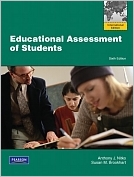| |||||
• polskie
• Zamów informacje o nowościach z wybranego tematu • kontakt |
EDUCATIONAL ASSESSMENT OF STUDENTS INTERNATIONAL EDITIONNITKO A. BROOKHART S.wydawnictwo: PEARSON ED, 2010, wydanie VIcena netto: net price + 5% vat. This highly respected text offers the most comprehensive discussion of traditional and alternative assessments of any classroom assessment text—explaining, giving examples, discussing pros and cons, and showing how to construct virtually all of the traditional and alternative assessments teachers use in the classroom. The author explores assessment theories and research findings as they affect teaching and learning, and examines why, when, and how teachers should use assessment in the classroom. To the text's hundreds of practical examples are added checklists to aid in evaluating assessment vehicles and scores of strategies for assessing higher-order thinking, critical-thinking, and problem-solving skills. Table of Contents Part I The Bases for Assessment 1 Classroom Decision Making and Using Assessment 2 Describing the Goals and Learning Targets of Instruction 3 Validity of Assessment Results 4 Reliability of Assessment Results 5Professional Responsibilities, Ethical Behavior, and Legal Requirements in Educational Assessments Part II Crafting and Using Classroom Assessments 6 Planning for Integrating Assessment and Instruction 7 Diagnostic and Formative Assessments 8 Completion, Short-Answer, and True-False Items 9 Multiple-Choice and Matching Exercises 10 Essay Assessment Tasks 11 Higher-Order Thinking, Problem Solving, and Critical Thinking 12 Performance and Portfolio Assessments 13 Preparing Your Students to Be Assessed and Using Students’ Results to Improve Your Assessments 14 Evaluating and Grading Student Progress Part III Interpreting and Using Standardized Tests 15 Standardized Achievement Tests 16 Interpreting Norm-Referenced Scores 17 Finding and Evaluating Published Assessments 18 Scholastic Aptitude, Career Interests, Attitudes, and Personality Tests
Appendixes Glossary References Name Index Subject Index 552 pages, Paperback
Po otrzymaniu zamówienia poinformujemy pocztą e-mail lub telefonicznie, |


